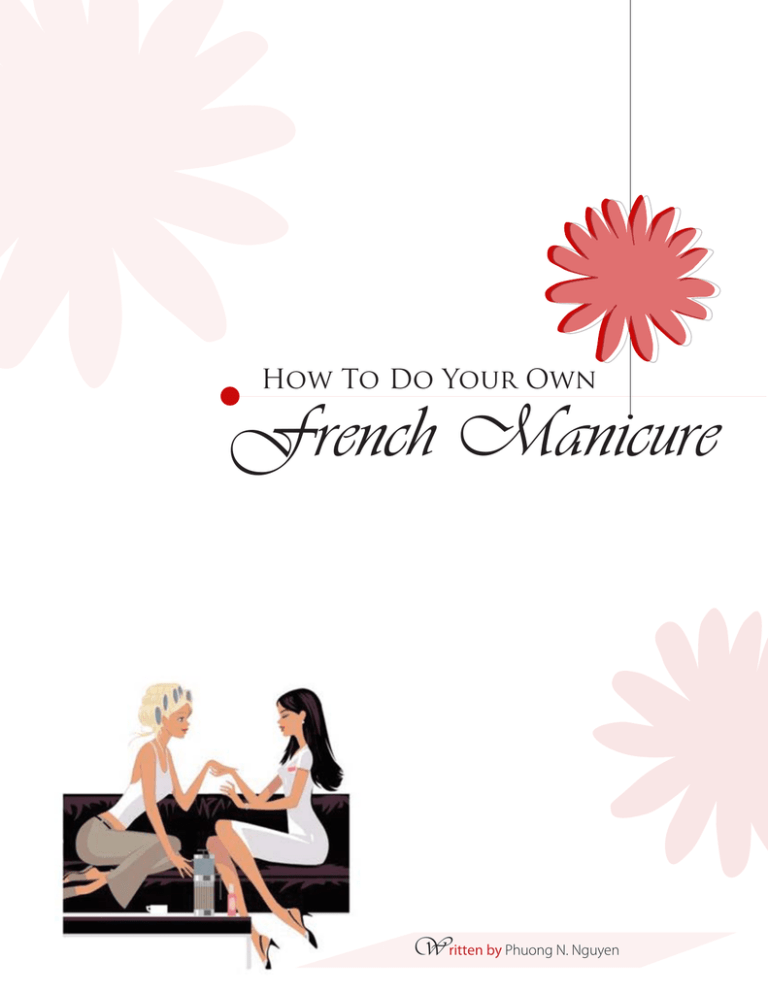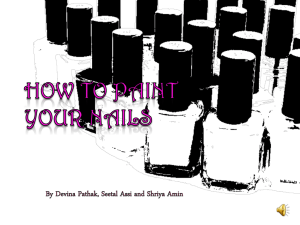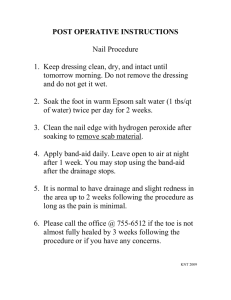French Manicure How To Do Your Own W ritten by
advertisement

How To Do Your Own FrenchManicure Manicure French Written by Phuong N. Nguyen Contents and Introduction c French Manicure A Short History ontents Contents and Introduction 1 Preparation and Supplies 2 Hand and Nail Care 3 Cuticles and Nail Polish 4 White Nail Polish Application 5 Top Coat Application 6 Maintenance and Myths vs. Facts 7 The French Manicure is pale pink or beige, naturallook with white-tips. It is a classic nail design offered at most nail salons or sold as a kit on the shelves of most convenient stores. But what is it and where did it come from? Manicures, in general, have been around for nearly 5,000 years and were initially intended for the elite females. As for the French Manicure, there are some who claim the designer Max Factor invented the design for the Paris factionists in the 1930s. Others have also claimed that the word 'French' when applied to anything can make that particular product sound chic and sophisticated, therefore, it became a marketing agent. The term 'Original French Manicure' was trademarked in 1978 by the cosmetic company Orly, who made the first home French Manicure kit. Despite the 'effortless' tag on the French Manicure, the actual manicure is not the easiest design to paint onto your nails. The whitening of the tip requires a good eye and a steady hand. Much easier if you have a manicurist doing it for you, not so easy if you are painting the tips on with your offhand. It takes time, patience, and practice to perfect this art form. Nail Preparation & Tip Application: White Tip Drying Time: Top Coat Drying Time: 15 minutes 10 minutes 20 minutes Time to Completion: 45 minutes The intended users for these instructions range from young female adults to older women. There are many variations to creating this classic look. In the following pages is one variation to performing your own French Manicure. 1 Preparation and Supplies French Manicure Preparation Before you begin to do the French Manicure make sure you have ample time to complete the procedure. Set aside at least an hour of non-physical disturbances. Ensure that the working area and tools you are working with are clean and conveniently located in front of you. Also make sure to have proper lighting so that you are able to see what you are doing. These preparations should apply for when you are doing your own French Manicure or doing it for someone else. Nail Polish Remover Hand Moisturizer Cotton Ball Nail Polish Cotton Swab Emergy Boards (filer) Cuticle Pusher Supplies Cotton balls Nail polish remover Hand-warm water Lint-free towel Hand moisterizer lotion Almond Oil BuyingTips: To remove acrylic nails (fake nails attached to your existing nail), you would want to buy the acetone nail polish remover. If you have acrylic nails on or just regular nails and want to remove the polish only, you want to buy a remover that has no acetone. There are also polish remover for different needs, such as dry cuticles and brittle nails. A few polish removers can add vitamins to stimulate growth and healthy nails. Cotton swabs Emery board (nail file) Cuticle pusher White nail polish Translucent beige/pink nail polish 2 French Manicure Hand and Nail Care Step 1 Preparing p g Nails 1 It is essential to prepare your hands and nails before applying nail polish. If you have nail polish currently on your nails, remove the polish with a cotton ball soaked in nail polish remover. Then wash your hands using a small amount of hand soap. Rinse with luwater and dry thoroughly with a lint-free towel. One of the main causes of chapped hands is not drying them properly after washing and not putting on a hand moisturizer. Make sure to dry your hands and get into the cuticle grooves before applying moisturizer all over. Figure 1: Apply a small amount of hand moisturizer all over your hands after wash. Step 2 Filingg Nails 2a Most manicurists recommend letting the free edge of your nails extend a few millimeters beyond the fingertip. This cuts down on nail breakage, and allows you to still take on manual labor. To correctly file your nails, delicately caress the nail with single-direction strokes. Start at the outer edge of one nail, and move the emery board gently, at a 45 to 90 degree angle against the edge, along the nail towards the center. Repeat the same filing movement on the other side, working out from the opposite edge to the center. Maintain filing in this manner until all nails are the in the desired shape. Choose a nail shape that enhances the shape of your finger. Keep in mind these suggestions: Figure 2A: Filing begins from the outer corner gliding towards the center of the nail. 2b Petite hands and fingers look best with almond shaped nails. Short and stocky fingers look best with squoval shaped nails. (There's a manicurist term to impress your friends - it means "squared-off oval.") Heavy set hands look best with squared off ends. This is also true for fingers with wide nail beds (the main body of the nail that defines its shape). Caution: Never file too deeply into the corners for you might get an infection. Also, side growth makes the nail look longer. Figure 2B: The squoval shape (above) fits appropriately with the French Manicure look. 3 French Manicure Cuticles and Nail Polish Step 3 Pushingg Back Cuticles 3 Coat hands in a layer of almond oil, to nourish and soften the nail area. Then wrap your hands in a warm towel and relax for 15 minutes. Unwrap your hands and gently push back the cuticles using a rubber hoof stick (cuticle pusher). Never use cuticle clippers because they can nick the skin. Rinse hands with warm water and dry thoroughly to remove any oil residue. Figure 3: Gently push cuticles back with rubber cuticle pusher. Step 4 Preparing p g Nail Polish 4a Shaking the nail polish bottle creates bubbles in the bottle which can be picked up by the brush and then transferred to the nail. To cut down significantly on bubbles ROLL the bottle between your palms. BUBBLES Bubbles can also be caused by insufficient drying time between coats or by temperature influences that make the nail polish dry unevenly (for example, high humidity, low room temperature or hot sun). If there is not sufficient time for nail polish to dry thoroughly between coats, polish solvents (particles in nail polish) can push up through the top coat, forming tiny bubbles. Bubbles may also form when polish is applied too thick. The solvents will not evaporate as quickly as they should and will be trapped under the next coat of polish, forming bubbles as they try to escape. Warning: Nail polish removers and nail polishes are flammable. They should be stored in a dry room temperature place away from electrical outlets, stoves and other heat sources. Figure 4A: Shaking the bottle whips air pockets into the polish causing bubbles to form. 4b Figure 4B: Rolling the bottle between your palms mixes the polish and prevents the transferred bubble look. 4 French Manicure White Nail Polish Application Step 5 Painting White Tips Paint even strokes of the white polish onto the top of the nail bed one-third to half way outwards. After painting the first coat, apply a second coat to fill in exposed areas. When applying polish, lay your hand on a flat surface and keep the ball of your painting hand steady. Keep the ball of your painting hand steady by resting it on the same surface. Paint all 10 finger nail tips and without waiting for the polish to dry immediately go to step 6. Step 6 Cleaning Up White Tips 5 Figure 5: Paint white polish in an outward direction towards the nail tip beginning from one side of the nail over to the other. 6a 6b 6c Figure 6A: Pour a small amount of nail polish remover into its cap to easily dip cotton swaps. Figure 6B: Sweep the dipped cotton swap from one end of the nail to the other in a single direction. Figure 6C: Shape white tips porportionally to the size of your nail. Remove excess polish on the nail bed with swap. 6d 6e Figure 6D: Remove any other white polish around the nail bed area. Figure 6E: Finished white tip shaping. Tip: Lightly buff the top of your nail with a fine-grained file. This will take away the top oily enamel and allow better nail polish adhesion. Cleaning up the white tips is essential to the overall look of the French Manicure. It is better to sweep the dipped cotton swab in short strokes across the nail to manipulate into the shape you desire. Clean up excess white polish on exposed nail bed and finger tip area around nail edge. 5 French Manicure Top Coat Application Step 7 Painting Top Coat 7 3 1 2 Finally, apply a coat of translucent shell-pink polish over the entire nail to seal the whitened tips and complete the look. To start, pick up a small amount of polish on your brush and stroke a thin layer of polish down the center of your nail (1 on figure 7). Your brush should hold just enough color to accomplish this. Stroke the sides of the nail and you are Figure 7: Start at base just above the done (2 & 3 on the figure 7). The nail should be completely colored in cuticle line and apply nail polish going up three strokes. Use the "flat-out" approach. The brush should be splayed and out towards the nail’s edge. out against the nail horizontally. Don't just use the tip of the brush. Use the whole brush. Using the "flat-out" approach means thinner layers which will ultimately give a more professional look. Let polish set for a minute or so before applying the second coat using the previously explained technique. After the second coat wait until polish is set (dry to the touch) and then for extra shine and protection, apply a clear, glossy top coat in the same manner. Don't skip this step because it adds life to your manicure and will protect your nails as well. Allow 20 minutes for nail polish to completely dry. Tip: Nail polish can be stored in the fridge. If your nail polish is too thick, thin it out with polish thinner. To prevent the cap from sticking, coat it with a little Vaseline. 6 Maintenance & Myths vs. Facts French Manicure Step 8 Nail Maintenance The clear top coat is the main coat of your manicure. You should make sure that you renew your top coat every other day to maintain your French Manicure. Don’t forget to continually moisturize, moisturize, moisturize! Myths vs. Facts Myth: Biting nails causes brittle nails. Fact: Cutting or biting nails actually helps nails grow at a faster rate. On average, your nails grow about 1/8 of an inch per month. Myth: Cuticles are kept neat by cutting them. Fact: Cuticles should never be cut. It is your body’s armor. The cuticle protects the nails from infection. When you cut them, they will grow back thicker and harder, and possibly create an infection. The best way to care for your cuticles is to apply good quality cuticle oil on them and gently push them back with a orangewood stick or rubber cuticle pusher. Myth: White spots on nails are caused by not drinking enough milk. Fact: What they are, are clusters of immature nail cells that have not fully hardened. Once a young adult’s system settles down, the problem will disappear. A white spot can also occur with trauma or by continually knocking the nail. Myth: Green nail is a fungus. Fact: Moisture leaking or being trapped between the nail and nail plate causes green nail. This moisture contains a simple bacterium (not a fungus) known as pseudomonas which multiplies very quickly. The waste products from these bacteria cause the nail plate to become stained green. 7







